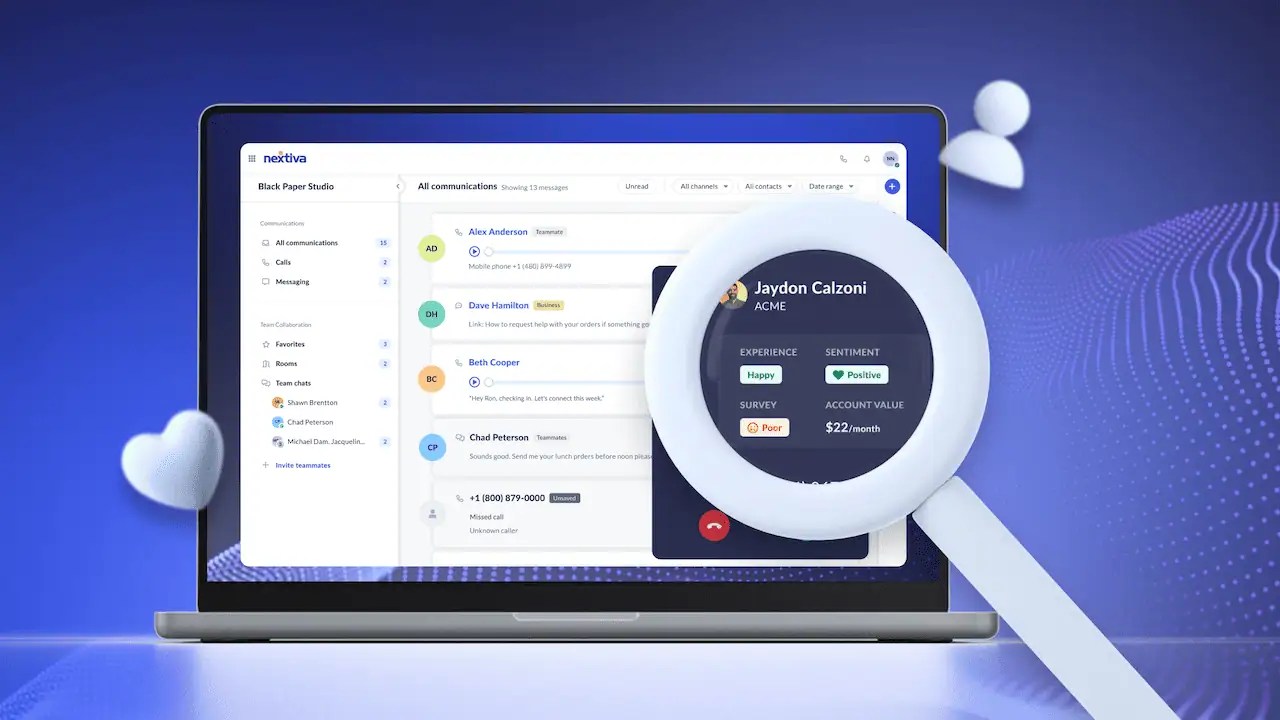Keeping your contact center’s staffing levels just right can be a tricky balancing act. You need to ensure you have enough agents available to answer all your incoming calls without wasting resources by having too many workers on a single shift.
So, how do you properly balance your staffing levels?
Contact center scheduling software provides a powerful solution, as it can predict your necessary staffing levels and balance schedules to ensure you’re never over- or understaffed.

How does scheduling software work, and how can you fully utilize it in your call center? Let’s explore.
Challenges of Contact Center Scheduling
First, you need to understand the challenges contact center supervisors face when scheduling agents. That will help you fully comprehend what obstacles scheduling software helps address.
Fluctuating call volumes
Call centers rarely ever receive a consistent number of calls throughout the day. Instead, there are peak and off-peak times, when call volumes can increase significantly or decrease to barely any activity.
Call center scheduling agents must always ensure they’re staffing the proper number of workers. This is critical, but it can also be complex without the right tools.

Employee preferences and availability
The more agents a contact center has, the more its schedules must be managed. Supervisors must balance employee time-off requests, preferred shifts, and availability to ensure everyone is properly scheduled.
This makes manual scheduling difficult, often leading to conflicts or dissatisfaction among agents.
Skills-based routing needs
Certain calls may need to be handled by agents with specific skill sets, such as fluency in a certain language, technical expertise, or experience dealing with a particular issue. It’s important to keep people with those abilities and expertise available throughout the day, but ensuring they’re on hand at the right time requires precise planning.

Overstaffing or understaffing
Figuring out the correct staffing levels can be hard. Overstaffing wastes resources, as agents sit around with nothing to do. Understaffing can cause long wait times, employee burnout, and an overall poor customer experience.
Your staffing levels should always be balanced so that your contact center always has just the right number of agents you need.
Compliance with labor laws
As important as it is to keep your contact center adequately staffed, it’s equally vital that your agents aren’t overworked. Schedules must take labor regulations into account, which include break times, overtime restrictions, and employee contract rules.
This is crucial from an ethical and legal standpoint, as noncompliance can lead to legal issues and employee dissatisfaction.
How Scheduling Software Helps
Given the many challenges call center supervisors face when scheduling agents, what features does scheduling software bring to the table, and how can it help?
Automated forecasting
While no one can predict the future, scheduling software can still identify patterns and trends to predict call volumes. The software uses historical data to determine when call volumes will be highest and lowest and can schedule agents based on the anticipated demand.
Improved flexibility
While balancing agent schedules, preferences, and time-off requests can be challenging for human supervisors, scheduling software can easily factor in these variables. Using this type of software reduces scheduling conflicts, helping to ensure that everyone gets the opportunity to work during the hours that they’re available and that time-off requests are being honored.
Real-time adjustments
No matter how well-planned your schedule may be, there’s always the chance of an unexpected incident throwing things into disarray. Agents could get sick or injured and be unable to come to work, or a new issue could cause an unforeseen surge in callers. When the unexpected happens, you need to be able to react quickly.
Scheduling software can adjust in real time to account for sudden or last-minute changes, such as absences or unexpected increases in call volume. This helps you react quickly and keep your contact center running smoothly no matter what obstacles come your way.

Better resource allocation
One of the biggest challenges to scheduling your call center is not just ensuring you always have the correct number of agents but also making sure those agents have the necessary skills and expertise.
This is another area where scheduling software can help, as it ensures that workers with the right skills are scheduled when they’re needed the most. This helps reduce bottlenecks and improve customer service so that callers can quickly get the help they need.
Labor compliance
When the software schedules agents, it follows all relevant guidelines and regulations. This includes ensuring that employees have properly scheduled breaks and aren’t working consecutive shifts and that your business complies with local labor laws, which reduces legal risks and improves job satisfaction.
Tips for Optimally Scheduling Your Contact Center
While contact center scheduling software will help you find the best way to schedule your agents, managers still make the final decisions about this matter.
Below are some tips to keep in mind when setting up your call center’s schedules:
Use historical data to forecast demand
You can learn from the past to identify what future calls will hold. Relying on historical call volume data to predict future demand is important so you can keep your contact center properly staffed.
When forecasting demand, it’s also crucial to factor in seasonal patterns and events such as promotions and new product launches. Considering all these variables will allow you to create accurate schedules to meet caller demands.
Schedule based on agent skills
Not all calls require the same skills. When assigning agents to shifts, make sure they’re given tasks that will match their abilities and areas of expertise. This will help ensure calls are resolved more smoothly and that your team members work under less stressful conditions.
Plan for flexibility
When setting up schedules, you must expect the unexpected and include a built-in buffer. In case an agent gets sick or doesn’t show up, you should have on-call agents ready to go. Similarly, if there’s an unexpected surge in calls, you should have agents prepared to step in.
Being able to adjust schedules quickly or having people on call is essential, as it ensures you’re prepared to adapt to unexpected circumstances and that your contact center will meet its staffing needs.
Offer agents scheduling flexibility
No matter how much data and planning goes into a schedule, it must be adjusted sometimes. Agents should be allowed to swap shifts or bid on available shifts to ensure they work the best hours for their personal schedules.
Giving employees some level of control over their scheduling improves morale, job satisfaction, and even retention. It helps agents feel more in charge of when they work and ensures they’re working the shifts they prefer.
Monitor and adjust in real time
Contact center supervisors must be prepared to adjust scheduling and staffing as needed. Monitoring key performance metrics, such as average handle time and call abandonment rates, provides quick insights into the contact center’s performance and efficiency so supervisors can see if anything needs to be fixed or adjusted.
If you can quickly modify schedules to meet your contact center’s needs, you’ll be poised for success even in the most unexpected circumstances.
Communicate clearly with agents
Communication is important in all aspects of life, and it’s especially crucial in work environments. Agents should have easy access to their schedules, such as through a mobile app or email notifications, and should be able to receive messages or alerts if they’re on call and needed.
Communication goes both ways, of course. Agents should also be able to contact their supervisors to inform them about any upcoming time-off requests, sick days, or other issues or to make requests to switch shifts. Keeping communication open and clear prevents confusion and reduces absenteeism.
Contact Center Software With Scheduling Features
Now that you know about the benefits of contact center scheduling software and its best uses, the next step is to look at contact center solutions that offer scheduling features. Here are five contact center and call center service providers that can help automate your scheduling:
1. Nextiva

Nextiva is an all-in-one contact center solution, including powerful scheduling tools integrated with its Voice over Internet Protocol and customer relationship management (CRM) features.
Additionally, Nextiva offers agents mobile access so that contact centers can operate efficiently from anywhere. With call monitoring, supervisors can assess customer interactions in real time and manage their agents from a single interface, regardless of where they’re based.
Nextiva’s key features include:
- AI-based call volume forecasting
- Skills-based routing
- Real-time monitoring
- A mobile app for contact center agents
- Integrations with most CRM tools
- Adherence tracking
Nextiva is ideal for midsize-to-large contact centers, especially those seeking sophisticated forecasting tools and flexible scheduling options.
2. Genesys Cloud CX

Genesys is a big name in the contact center market. Genesys Cloud CX offers workforce management tools that provide real-time call monitoring, call volume forecasting, and automated scheduling to balance agent schedules. Additionally, it has skills-based routing to direct calls to the most qualified agent available for each customer query and performance analytics to help optimize agent productivity.
Genesys Cloud CX is ideal for large enterprises, particularly those that need detailed insights into agent performance and advanced forecasting tools.
3. Five9

Five9 is a fine choice for contact centers that handle a high volume of customer interactions and often need to adjust their schedules in real time.
Five9 offers predictive workforce management, skills-based scheduling, and real-time analytics, allowing managers to monitor calls and call centers as needed. Should there ever be an unexpected change in call volume, managers can adjust their contact center’s schedules on the fly, as this provider gives them the flexibility and reactivity they need to keep up with any changes.
4. Talkdesk

Talkdesk offers intelligent workforce management, which uses AI-powered technology to forecast call volume. This solution also includes adherence tracking, mobile-friendly scheduling features, and seamless integrations with CRM tools that make scheduling and performance tracking streamlined and painless.
Talkdesk is a good choice for small-to-midsize contact centers, particularly those looking for easy-to-use scheduling tools and strong CRM integrations.
5. NICE inContact

Large enterprises looking for highly customizable scheduling options may want to consider NICE inContact. It offers comprehensive workforce management, complete with automated scheduling, real-time adherence tracking, and forecasting based on historical data.
NICE inContact offers a wide range of customization options, which are highly beneficial for enterprises with complex scheduling. Organizations with diverse agent requirements and global operations will find customization helpful.
Scale Your Contact Center (Not Your Costs) With Nextiva
Anyone who manages a contact center knows the importance of keeping it properly staffed. A good scheduling solution can make the difference between an understaffed, overworked contact center and an efficient, optimized team.
Managers looking to ensure their contact centers are fully staffed will want to invest in tools that provide automated forecasting, flexible scheduling features, and the ability to balance schedules. With the right technology, you can reduce employee burnout and dissatisfaction while increasing efficiency across your contact center.
If you’re looking for a powerful contact center solution with robust scheduling tools, you’ll want Nextiva. Nextiva’s solution makes it easy for managers to monitor their contact centers, set and adjust agent schedules, and ensure they have the right personnel available at all times.

When you want a contact center that can both delight your customers and keep your agents happy, Nextiva has the tools and features you need.
Nextiva is your contact center scheduling software solution.
Maximize contact center ROI.
Accurately forecast staffing needs, promote agent empowerment, and trim costs with Workforce Scheduling software.

















 Productivity
Productivity 









